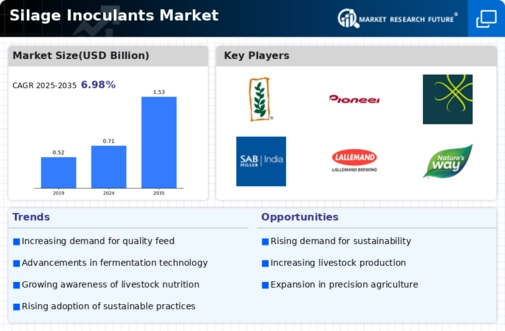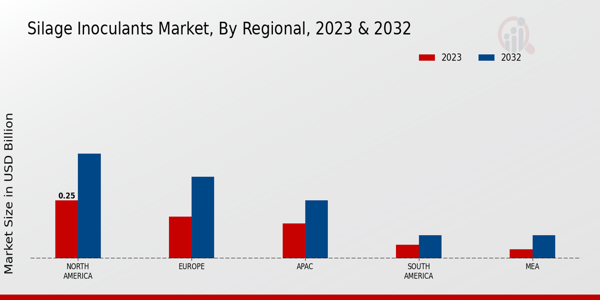Market Growth Projections
The Global Silage Inoculants Industry is poised for substantial growth, with projections indicating a market value of 0.71 USD Billion in 2024 and an anticipated increase to 1.53 USD Billion by 2035. This growth trajectory suggests a compound annual growth rate of 7.22% from 2025 to 2035, reflecting the increasing adoption of silage inoculants in livestock production. Factors contributing to this growth include rising demand for high-quality forage, technological advancements, and regulatory support for feed quality improvement. The market is likely to evolve as producers seek innovative solutions to enhance livestock health and productivity.
Expansion of Livestock Production
The expansion of livestock production across various regions is a significant driver for the Global Silage Inoculants Industry. As the global population continues to grow, the demand for meat and dairy products is increasing, prompting farmers to enhance their production capabilities. Silage inoculants are instrumental in improving feed efficiency and overall livestock health, making them a valuable asset for producers. This growing demand is projected to elevate the market value to 1.53 USD Billion by 2035, reflecting the critical role of silage inoculants in meeting the nutritional needs of livestock.
Rising Demand for High-Quality Forage
The increasing global demand for high-quality forage is a primary driver of the Global Silage Inoculants Industry. As livestock producers seek to enhance the nutritional value of feed, the use of silage inoculants becomes essential. These products help in improving fermentation quality, which in turn leads to better animal performance. In 2024, the market is projected to reach 0.71 USD Billion, reflecting the growing recognition of silage inoculants as a vital component in forage management. This trend is expected to continue as the livestock sector expands, particularly in regions with high meat and dairy consumption.
Regulatory Support for Feed Quality Improvement
Regulatory frameworks aimed at improving feed quality are influencing the Global Silage Inoculants Industry. Governments worldwide are implementing policies that encourage the use of high-quality feed additives, including silage inoculants, to enhance livestock health and productivity. These regulations often promote the adoption of best practices in feed management, thereby increasing the demand for effective inoculants. As a result, producers are more likely to invest in these products to comply with standards and improve their operational efficiency. This regulatory support is expected to bolster market growth in the coming years.
Growing Awareness of Sustainable Farming Practices
The increasing awareness of sustainable farming practices is driving growth in the Global Silage Inoculants Industry. Farmers are increasingly adopting methods that reduce waste and improve resource efficiency, and silage inoculants play a crucial role in this transition. By enhancing fermentation and minimizing nutrient loss, these products contribute to more sustainable livestock production. As consumers demand more environmentally friendly practices, the market for silage inoculants is expected to expand. This trend aligns with global sustainability goals and is likely to support the market's growth trajectory, particularly as producers seek to meet regulatory standards.
Technological Advancements in Inoculant Formulations
Technological innovations in the formulation of silage inoculants are significantly influencing the Global Silage Inoculants Industry. Advances in microbial technology have led to the development of more effective and targeted inoculants that enhance fermentation processes. These innovations not only improve the preservation of nutrients but also reduce spoilage, thereby increasing overall silage quality. As producers become more aware of these benefits, the adoption of advanced inoculants is likely to rise. This shift is anticipated to contribute to a compound annual growth rate of 7.22% from 2025 to 2035, indicating a robust future for the market.






















